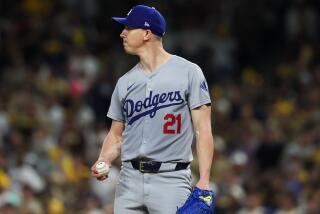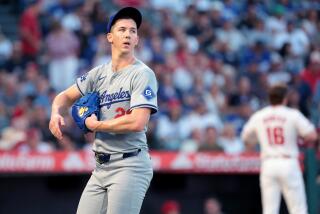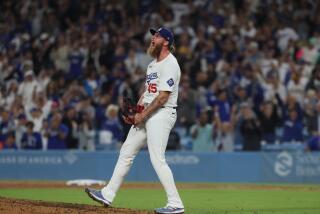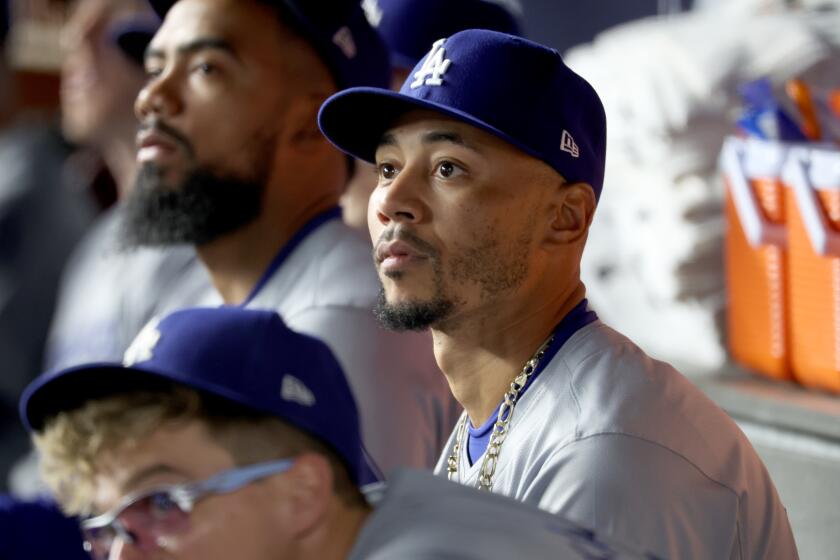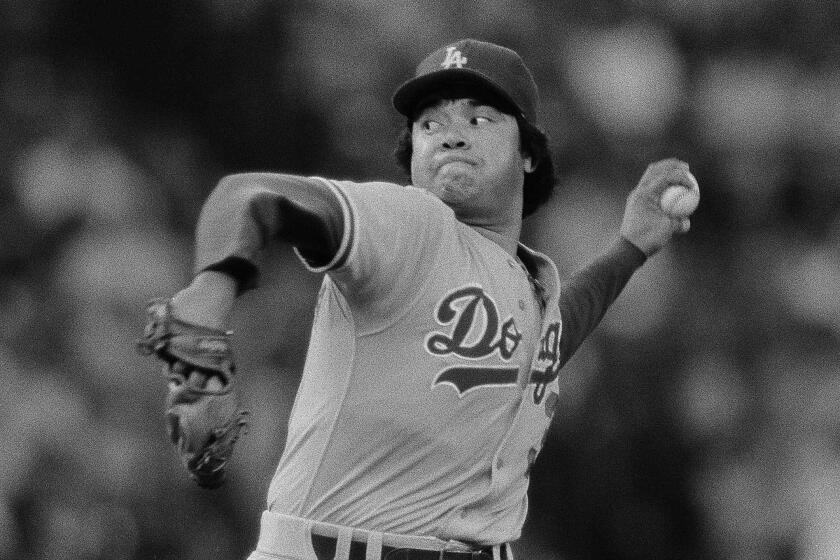Love it or hate it, platooning is a big part of the Dodgers’ strategy
Cody Bellinger, the reigning National League rookie of the year, started at first base in the Dodgers’ pivotal 5-2 win over the Colorado Rockies on Wednesday. He batted clean up, an appropriate spot for someone with 23 home runs. And, yet, it was a minor surprise.
The Rockies started a left-handed pitcher, Tyler Anderson, and Bellinger had been benched the previous eight times the Dodgers faced a left-hander. He hadn’t started against a left-hander since Aug. 29 as the Dodgers became platoon devotees to maximize production for the stretch run. On Wednesday, Bellinger’s restriction was lifted.
“It’s different, but we’re doing everything we can to get into the playoffs,” said Bellinger, who went 0 for 4 Wednesday and has a .703 on-base-plus-slugging percentage against left-handers this season — 200 points lower than his mark against them last season.
“So it’s unfortunate, but you can’t really argue about it. Everyone’s been doing their part. You can’t complain about it and you try to perform when you’re out there.”
The Dodgers are masters in roster manipulation. They use the disabled list aggressively. They bounce pitchers between the rotation and bullpen. And, recently, they’ve become unforgiving platoon stalwarts in their push to another playoff berth. Their main trade acquisitions this season allowed for further maneuvering. Manny Machado, Brian Dozier and David Freese, all right-handed batters, have fortified the club against left-handed pitching and allowed them to implement platoons nearly across the board.
Machado, an All-Star, plays every day at shortstop. Third baseman Justin Turner, arguably baseball’s best hitter in the second half, is the only other constant in the lineup. Besides them, the lineup is in daily flux, platoons everywhere even though Max Muncy, a left-handed batter leading the Dodgers with 33 home runs, has a .922 OPS against left-handers. Manager Dave Roberts explained defense is a reason Muncy, who has primarily played first base in recent weeks, has been limited to starts against right-handers.
“You look at a lot of the guys that have been here the last few years, they understand kind of what we do — in some cases,” Roberts said. “Every manager, every organization wants a player that you can run up there every day, left-handed, right-handed, it doesn’t matter, it doesn’t affect their production. But when you have as many good players as we have and there is a discrepancy with two players and one’s better against left, one’s against right, for us there’s too much upside not to exploit that.”
Roberts said he constructs his lineups days in advance. They change if an injury or another variable pops up, but the composition is usually established. He’s penned 147 different lineups this season. Six have been used twice. He used 147 last season and 120 in 2016.
September’s roster expansion has granted him more choices to start games and to finish them. On Wednesday, for example, he used five pinch-hitters to counter the Rockies’ bullpen. One, Yasiel Puig, walloped the go-ahead three-run home run in the seventh inning to push the Dodgers 2½ games ahead in the National League West.
The flexibility is a luxury that employing 19 position players on a 39-man active roster provides — and one the Dodgers won’t enjoy if they make the postseason, when rosters dwindle back to 25 and players must produce in less-than-optimal matchups. Could that ultimately hurt the Dodgers?
“It’s twofold because I think you have to do what potentially you’re going to do in the postseason with a 25-man roster,” Roberts said. “But there’s a reason why we’re carrying 39 guys. And to not deploy these guys, or use them when it gives you a better chance to win, where you’re fighting your life, that right there, that logic doesn’t make sense. And I think it’s one of those things you’ve got to get there first and we’ll deal with that.”
Puig is an unusual but apt example. The right-handed-hitting outfielder has reverse splits — meaning he hits right-handed pitchers better than left-handers. The difference is stark. Puig is batting .304 with a .935 OPS against right-handers and .216 with a .665 OPS against left-handers this season. He is 12 for his last 25 with six home runs. Five have come against right-handers. He became the hero Wednesday with help from the Rockies, who decided to have a right-hander pitch to him with first base open. The Dodgers have placed him in position to succeed and he has thrived.
Tuesday’s hero was not given an ideal canvas.
Chris Taylor started Tuesday for one reason: The Rockies started Kyle Freeland, one of baseball’s premier left-handed pitchers. But the Rockies had right-hander Adam Ottavino on the mound in the 10th inning and Roberts had already used four left-handed pinch-hitters. So Taylor, who had moved from left field to center field to second base, faced Ottavino. He clubbed a walk-off homer anyway to keep the Dodgers in first place.
“He really epitomizes what we’re all about as a team,” Roberts said of Taylor. “As far as loving the big moment, coming through with big hits, really making a huge sacrifice, but being prepared when called upon… This game honors you. It has a great way of doing that.”
Twitter: @jorgecastillo
More to Read
Are you a true-blue fan?
Get our Dodgers Dugout newsletter for insights, news and much more.
You may occasionally receive promotional content from the Los Angeles Times.
